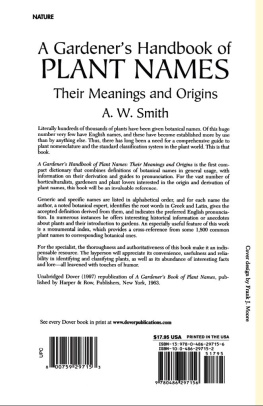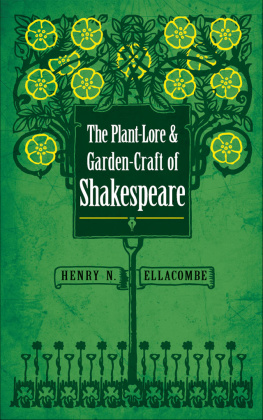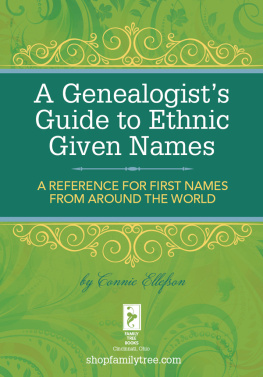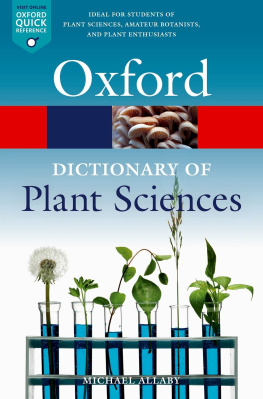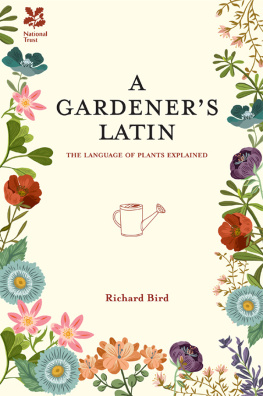Dictionary of Plant Lore
Donald Watts, BA MIL
Bath, United Kingdom
Academic Press
Copyright
Academic Press is an imprint of Elsevier
30 Corporate Drive, Suite 400, Burlington, MA 01803, USA
525 B Street, Suite 1900, San Diego, California 92101-4495, USA
84 Theobalds Road, London WC1X 8RR. UK
This book is printed on acid-free paper 
Copyright 2007, Elsevier Inc. All rights reserved.
No part of this publication may be reproduced or transmitted in any form or by any means, electronic or mechanical, including photocopy, recording, or any information storage and retrieval system, without permission in writing from the publisher.
), by selecting Support & Contact then Copyright and Permission and then Obtaining Permissions.
Library of Congress Cataloging-in-Publication Data
Application Submitted
British Library Cataloguing-in-Publication Data
A catalogue record for this book is available from the British Library.
ISBN 13: 978-0-12-374086-1
ISBN 10: 0-12-374086-X
For information on all Academic Press publications
visit our Web site at www.books.elsevier.com
Printed in the United States of America
07 08 09 10 9 8 7 6 5 4 3 2 1

Dedication
In Memory of Megan and Don
PREFACE
Sadly, this book is published posthumously. It results from the authors interest in plant and tree lore and ethnobotanical studies developed over several decades of research and teaching. Although the author was checking the first print at the time of his death, any inaccuracies or omissions would undoubtedly have been rectified if he had lived a few months longer, and I can only apologise for these.
Throughout the book there are references to recipes of the past use of plants for a variety of usessome of which would be considered highly imaginative or mythical today. It goes without saying that such recipes should not be attempted by the lay person, but should be seen in the light of mans evolutionary understanding of the potential of plants within the culture and environment that he lived.
The author had a very considerable collection of antiquarian books, but I would like to acknowledge the excellent support he received from the London Library and West Wiltshire Libraries. I would also like to thank Sheila Tomkinson for her generous help with proof-reading.
S. Watts
A
Abies alba > SILVER FIR
Abies balsamea > BALSAM FIR
ABORTION
). Indeed, the poisonous oil of tansy has long been taken to induce abortion (Grigson). Exactly the same ambivalence is shown in beliefs concerning PARSLEY. It is an aid to conception on the one hand, and a contraceptive as well as an abortifacient on the other. Cambridgeshire girls would eat it three times a day to get an abortion, but the belief is actually widespread (Waring). Eating HORSERADISH leaves three times a day was a valued means in the Fen country of causing abortion (Porter. 1968), knowledge apparently not confined to East Anglia, for Whitlock mentions it as a Wiltshire remedy, if that is the right word to use.
) in the mid-19th century. SAVIN, probably the most notorious of the poisonous abortifacients, had been in use, as a matter of common knowledge, since ancient times, and was certainly well known in the 16th and 17th centuries, for instance, the scurrilous lines in Middletons play, A game of chess, act 1; sc. 2:
To gather fruit, find nothing but the savin-tree,
Too frequent in nuns orchards, and there planted
By all conjecture, to destroy fruit rather.
). Even ARNICA, dangerous as it is, has been used in folk medicine (Schauenberg & Paris). MARSH ROSEMARY (Ledum palustre) is another traditional abortifacient (Schauenberg & Paris), and even the dried flowers of FEVERFEW have been used in Europe (Lewis & Elvin-Lewis). A volatile oil made from the wood of VIRGINIAN JUNIPER, a close relative of Savin, has been used for abortions (Weiner); if this is the substance known as Red Cedar Wood Oil, then it must have been a thoroughly dangerous process (Usher). It is claimed that the Blackfoot Indians used the rhizome of SWEET FLAG to cause abortions (Johnston). That sounds highly unlikely, considering the plants universal usage as a mild carminative.
) with good reason, for it has often been used for abortions (Clair). French folklore insists that there was a law forbidding its cultivation in ordinary gardens. It was said that the specimen in the Paris Botanical Garden had to be enclosed to prevent pregnant girls from stealing it. In the Deux-Savres region of France it was believed that it caused any woman who merely touched it with the hem of her dress to miscarry (Sebillot). HEMP leaves were recommended in Cambridgeshire, the aim being to cause severe vomiting, often enough to result in a miscarriage. In the Scottish Highlands, it seems that the MOUNTAIN CLUBMOSS was used for the purpose. James Robertson, who toured the West Highlands and Islands in 1768, noted that the Lycopodium selago is said to be such a strong purge that it will bring on an abortion (quoted in Beith).
). BITING STONECROP is traditionally known as abortive (Schauenberg & Paris). A Middle English Rimed Medical Treatise has:
She that drynkes fumiter and the stoncrope
Schal neuere yong childe in cradell roke.
), surprising, perhaps, for a plant that is almost a panacea. But it is also an emmenagogue (Cameron), which would explain the usage.
It is said that a root decoction of the African tree CATCHTHORN (Zizyphus abyssinica) will cause abortion (Palgrave & Palgrave). BUSY LIZZIE was an African plant originally, and some groups used its root as an abortifacient (Watt & Breyer-Brandwijk). SCARLET LEADWORT (Plumbago indica) is a well known abortifacient in India and Malaysia, but it is a thoroughly dangerous practice, and could be lethal.
(P A Simpson). It is the root that is used, apparently by introduction into the vagina, and that would cause violent local inflammation (Gimlette). Its close relative, CEYLON LEADWORT (Plumbago zeylanica) is used in the same way in the Philippines (Watt & Breyer-Brandwijk), and in Guyana, where it is called Gully-root, the leaf decoction of GUINEA-HEN WEED (Petiveria alliacea) is used (Laguerre).
Abrus precatorius > PRECATORY BEAN
ABSCESS
), and in Ireland, a favourite treatment was to make a tea from BROOM tops, and bathe the place with this (Maloney). MADONNA LILY petals, macerated in alcohol, usually brandy, were bound to abscesses, boils and ulcers (Porter), and to all sorts of other skin eruptions. A poultice of WILD SORREL leaves was used in parts of South Africa to treat an abscess (Watt & Breyer-Brandwijk). Similarly, a poultice of chickweed is still prescribed by herbalists (Warren-Davis).
ABSINTHE
). Besides upsetting the nervous system, it irritates the stomach and increases heart action, and could cause disorientation, delirium and hallucination (Le Strange). At one time, wormwood was used in the preparation of all sorts of medicated wines and ales. Nowadays, extract of aniseed has replaced wormwood in aromatic liqueurs, in Pernod for instance, though small amounts of wormwood are still added to vermouth, which is a fortified white wine (Le Strange).
Acacia catechu > CUTCH TREE








